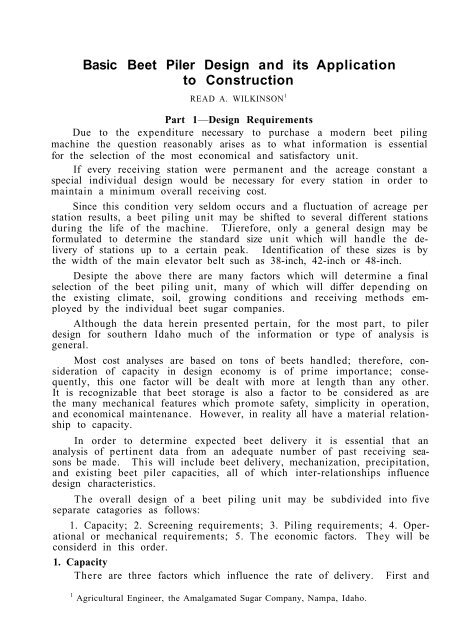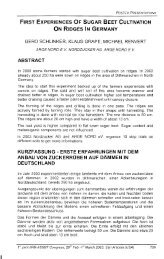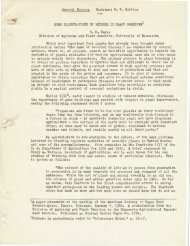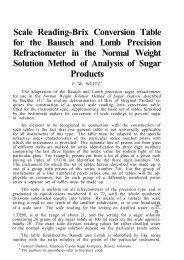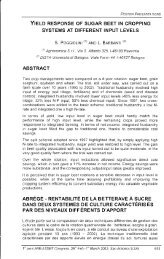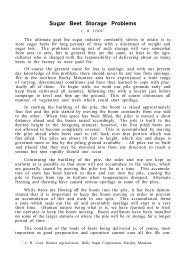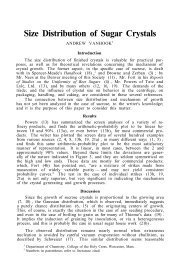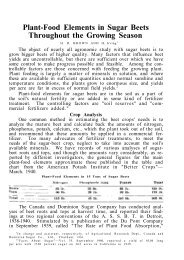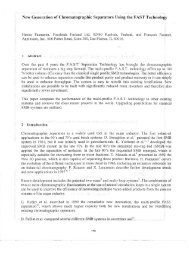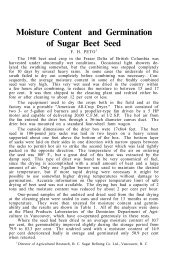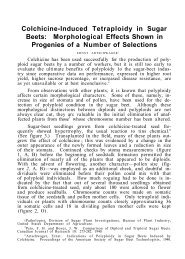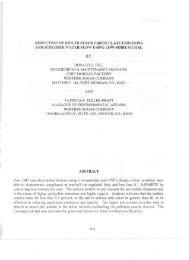Basic Beet Piler Design and its Application to Construction - ASSBT ...
Basic Beet Piler Design and its Application to Construction - ASSBT ...
Basic Beet Piler Design and its Application to Construction - ASSBT ...
Create successful ePaper yourself
Turn your PDF publications into a flip-book with our unique Google optimized e-Paper software.
<strong>Basic</strong> <strong>Beet</strong> <strong>Piler</strong> <strong>Design</strong> <strong>and</strong> <strong>its</strong> <strong>Application</strong><br />
<strong>to</strong> <strong>Construction</strong><br />
READ A. WILKINSON 1<br />
Part 1—<strong>Design</strong> Requirements<br />
Due <strong>to</strong> the expenditure necessary <strong>to</strong> purchase a modern beet piling<br />
machine the question reasonably arises as <strong>to</strong> what information is essential<br />
for the selection of the most economical <strong>and</strong> satisfac<strong>to</strong>ry unit.<br />
If every receiving station were permanent <strong>and</strong> the acreage constant a<br />
special individual design would be necessary for every station in order <strong>to</strong><br />
maintain a minimum overall receiving cost.<br />
Since this condition very seldom occurs <strong>and</strong> a fluctuation of acreage per<br />
station results, a beet piling unit may be shifted <strong>to</strong> several different stations<br />
during the life of the machine. TJierefore, only a general design may be<br />
formulated <strong>to</strong> determine the st<strong>and</strong>ard size unit which will h<strong>and</strong>le the delivery<br />
of stations up <strong>to</strong> a certain peak. Identification of these sizes is by<br />
the width of the main eleva<strong>to</strong>r belt such as 38-inch, 42-inch or 48-inch.<br />
Desipte the above there are many fac<strong>to</strong>rs which will determine a final<br />
selection of the beet piling unit, many of which will differ depending on<br />
the existing climate, soil, growing conditions <strong>and</strong> receiving methods employed<br />
by the individual beet sugar companies.<br />
Although the data herein presented pertain, for the most part, <strong>to</strong> piler<br />
design for southern Idaho much of the information or type of analysis is<br />
general.<br />
Most cost analyses are based on <strong>to</strong>ns of beets h<strong>and</strong>led; therefore, consideration<br />
of capacity in design economy is of prime importance; consequently,<br />
this one fac<strong>to</strong>r will be dealt with more at length than any other.<br />
It is recognizable that beet s<strong>to</strong>rage is also a fac<strong>to</strong>r <strong>to</strong> be considered as are<br />
the many mechanical features which promote safety, simplicity in operation,<br />
<strong>and</strong> economical maintenance. However, in reality all have a material relationship<br />
<strong>to</strong> capacity.<br />
In order <strong>to</strong> determine expected beet delivery it is essential that an<br />
analysis of pertinent data from an adequate number of past receiving seasons<br />
be made. This will include beet delivery, mechanization, precipitation,<br />
<strong>and</strong> existing beet piler capacities, all of which inter-relationships influence<br />
design characteristics.<br />
The overall design of a beet piling unit may be subdivided in<strong>to</strong> five<br />
separate catagories as follows:<br />
1. Capacity; 2. Screening requirements; 3. Piling requirements; 4. Operational<br />
or mechanical requirements; 5. The economic fac<strong>to</strong>rs. They will be<br />
considerd in this order.<br />
1. Capacity<br />
There are three fac<strong>to</strong>rs which influence the rate of delivery. First <strong>and</strong><br />
1 Agricultural Engineer, the Amalgamated Sugar Company, Nampa, Idaho.
PROCEEDINGS—EIGHTH GENERAL MEETING 345<br />
Figure 1<br />
foremost is the use of machines in harvesting the beets, second the weather<br />
<strong>and</strong> third the size of crops harvested.<br />
Graphs have been plotted from compiled data of these three fac<strong>to</strong>rs<br />
for the years 1946 through 1953 in the Nampa-Nyssa districts <strong>and</strong> the following<br />
deductions may be made as shown in Figure 1.<br />
1. An increase <strong>to</strong> 98 percent in mechanical harvesting is shown<br />
on curve A.<br />
2. Curve B portrays the variation in precipitation during the<br />
same period wherein it has been below normal for the majority<br />
of years.<br />
3. Curves C, D <strong>and</strong> E are based on the year 1946 from which<br />
the following deductions may be made: A gradual increase in delivery<br />
peaks have occurred since 1946, which directly follows the<br />
increase in mechanization. These peaks are lowered slightly in<br />
years of high precipitation <strong>and</strong> large beet crops, but not sufficiently<br />
<strong>to</strong> eliminate the continual rise.<br />
The fluctuation in <strong>to</strong>tal days harvest for each year as shown by Curve<br />
E follows quite closely the precipitation shown by Curve B <strong>and</strong> has gradually<br />
decreased.<br />
In Figure 2, delivery by the week was plotted in three characteristic<br />
years in which approximately the same <strong>to</strong>nnage was delivered <strong>and</strong> the precipitation<br />
was about the same. From this information it may be deduced<br />
that the time of peak delivery has remained about the same. In fact, out
346 AMERICAN SOCIETY OF SUGAR BEET TECHNOLOGISTS<br />
of the eight years investigated only one peak changed radically from the<br />
general pattern, <strong>and</strong> that was the year when the precipitation was the highest<br />
above normal. As will be noted from these curves, also the peak <strong>to</strong>nnage<br />
reached has increased each year as has the percent of fall mechanization.<br />
This increase in peak delivery is extremely important with regard <strong>to</strong><br />
piler design as it is this increase which affects the capacity <strong>and</strong> selection of<br />
the pilers used, since piler peaks au<strong>to</strong>matically follow <strong>to</strong>tal peaks where the<br />
same equipment is used. While this increase in peaks has been adequately<br />
h<strong>and</strong>led in the past due <strong>to</strong> the 56.5 percent average piler utilization, it will<br />
not be possible <strong>to</strong> continue <strong>to</strong> h<strong>and</strong>le it in the future as the maximum capacities<br />
of the un<strong>its</strong> are rapidly being reached. This is underst<strong>and</strong>able when<br />
an analysis is made of past receiving reports which show that average piler<br />
peaks have increased 16 percent in the last four years, as compared with<br />
weekly delivery peaks, which have increased only 7.4 percent.<br />
For example, in 1953 the piler utilization for the large delivery stations<br />
reached a peak of 89.5 percent with the maximum being reached just before<br />
noon <strong>and</strong> again before closing time. If the maximum capacity were<br />
Figure 2.—Weekly deliveries.<br />
maintained during the entire day, the situation would be extremely congested,<br />
thus curtailing the growers' harvest operations. Such a condition<br />
cannot be allowed, <strong>and</strong> changes are necessary <strong>to</strong> alleviate it, either in harvested<br />
acres or piler design.<br />
With mechanical harvesting increasing <strong>and</strong> the growers delivering beets<br />
more rapidly, the question arises as <strong>to</strong> what the ultimate delivery rate will<br />
be, or at what point should it be controlled. As seen in Figure 2, the time<br />
of delivery has been materially reduced between the years 1946 <strong>and</strong> 1953,<br />
which is inverse <strong>to</strong> the peak delivery trend. Therefore, it becomes necessary<br />
<strong>to</strong> determine whether it is desirable <strong>to</strong> increase or decrease the time for<br />
delivering beets. The determination of this fac<strong>to</strong>r is essential because upon<br />
it rests the conclusion as <strong>to</strong> whether piler capacities should remain as they<br />
are or be increased.<br />
Since design, as discussed in this paper, is predicted for the most part
PROCEEDINGS—EIGHTH GENERAL MEETING<br />
347<br />
Figure 3.—Temperature <strong>and</strong> precipitation—7-year average.<br />
on the piling of beets, it is necessary <strong>to</strong> determine the time period when<br />
it is most satisfac<strong>to</strong>ry <strong>to</strong> pile for s<strong>to</strong>rage. Fac<strong>to</strong>rs affecting s<strong>to</strong>rage consist of<br />
maximum <strong>and</strong> minimum temperatures <strong>and</strong> precipitation; therefore, the 7-<br />
year average of these for the Nampa-Nyssa district is plotted in Figure 3.<br />
Ideal temperature variation for sugar beet s<strong>to</strong>rage in southern Idaho<br />
is between 57° <strong>and</strong> 27° F., when precipitation is low <strong>and</strong> intermittent. In<br />
accordance with these limiting fac<strong>to</strong>rs, an analysis of the curves indicates<br />
that during the fore part of the season the maximum temperatures are the<br />
determining fac<strong>to</strong>r <strong>and</strong> in the latter part of the season the minimums are.<br />
Since there are only a few available days between these lim<strong>its</strong>, a large latitude<br />
must be included.<br />
Because the expected dry <strong>and</strong> warmer atmospheric conditions are more<br />
favorable for harvesting during the piling period than the cold <strong>and</strong> wet<br />
conditions, the shift should be in that direction. Further observation of<br />
the curves indicates that the final maximum temperature drop occurs on<br />
Oc<strong>to</strong>ber 15, thus establishing a date for the beginning of unrestricted harvest<br />
<strong>and</strong> pile s<strong>to</strong>rage. The minimum temperatures become unfavorable November<br />
9, which will determine this <strong>to</strong> be the latest pile date. The precipitation<br />
curve indicates that there is a period starting Oc<strong>to</strong>ber 10 through November<br />
8 whereby very little precipitation falls; thus, the 26-day period from Oc<strong>to</strong>ber<br />
15 up <strong>to</strong> <strong>and</strong> including November 9 is satisfac<strong>to</strong>ry as far as precipitation is<br />
concerned.<br />
Since it is necessary <strong>to</strong> start harvest two weeks before the beet s<strong>to</strong>rage<br />
season begins a certain percentage of the beets necessary <strong>to</strong> operate the fac-
348 AMERICAN SOCIETY OF SUGAR BEET TECHNOLOGISTS<br />
<strong>to</strong>ries must be harvested. This will approximate 1 percent per day, leaving<br />
the other 87 percent <strong>to</strong> be harvested in the remaining 26 days. Assuming<br />
1953 as a normal year with 98 percent of the harvesting being done mechanically,<br />
it can serve as a base upon which the pro-rated increase can be applied.<br />
The delivery for a 26-day period is, therefore, plotted in Figure 2<br />
<strong>to</strong> show the comparison. From past delivery data we have concluded that<br />
peak station delivery for the 48-inch pilers will amount <strong>to</strong> 1.33 percent of<br />
the delivery for the peak week, which amounts <strong>to</strong> approximately 4,000 <strong>to</strong>ns<br />
per day, or a 12 percent increase over the present peak delivery for the<br />
present 48-inch pilers. This increase may, of course, be taken care of by<br />
longer station hours, but the piler utilization data would indicate that it<br />
is an increase in hourly capacity which is necessary <strong>to</strong> reduce congestion <strong>and</strong><br />
not more hours. Therefore, we may conclude that the capacity in <strong>to</strong>ns per<br />
hour of pilers at peak stations should be increased by the above amount<br />
<strong>to</strong> h<strong>and</strong>le approximately 340 <strong>to</strong>ns per hour.<br />
2. Screening Requirements<br />
The modern piler requires a screen which will operate with greater<br />
efficiency <strong>to</strong> eliminate trash, dirt, rocks <strong>and</strong> clods. It is necessary that this<br />
be accomplished with a minimum amount of small beet loss <strong>and</strong> interference<br />
from mud.<br />
3. Piling Requirements<br />
S<strong>to</strong>rability of beets depends upon many fac<strong>to</strong>rs, among which are a<br />
few features which can be built in<strong>to</strong> a beet piler: namely, the ability <strong>to</strong><br />
au<strong>to</strong>matically spread the beets <strong>and</strong> escaping trash uniformly on the pile<br />
face. Also, the ability <strong>to</strong> build piles of different widths <strong>and</strong> heights without<br />
cutting down capacity from beets rolling back on the piling boom belt is<br />
important. This is essential in order that piles may be built for either<br />
natural or artificial ventilation.<br />
4. Mechanical Requirements<br />
There are many features on pilers which are desirable in that they<br />
reduce operational cost, maintenance, <strong>and</strong> provide convenience <strong>and</strong> safety.<br />
A piler must be mobile <strong>and</strong> compact as it is necessary <strong>to</strong> move these<br />
un<strong>its</strong> at times, especially from pile <strong>to</strong> direct car delivery. This requires a<br />
minimum amount of weight per square inch of track area on the ground.<br />
Adequate <strong>and</strong> positive steering is also desirable not only <strong>to</strong> aid in maneuverability,<br />
but <strong>to</strong> reduce the length of piling areas necessary.<br />
It is also essential that operation <strong>and</strong> controls of a piling unit be simply<br />
arranged for safety, <strong>and</strong> that consideration be given <strong>to</strong> minimum labor requirements<br />
for both operation <strong>and</strong> repair. Power <strong>and</strong> maintenance costs<br />
should also receive major consideration.<br />
All possible safety features, with regard <strong>to</strong> drives <strong>and</strong> electrical installations,<br />
should be incorporated in the unit.<br />
Roomy tare houses <strong>and</strong> provision for taking tare samples are desirable<br />
as are arrangements on some pilers for both side <strong>and</strong> end dump trucks.<br />
Initial <strong>and</strong> operational costs per <strong>to</strong>n of beets h<strong>and</strong>led should be kept<br />
as low as possible with regard <strong>to</strong> all sizes of beet pilers.
PROCEEDINGS—EIGHTH GENERAL MEETING 349<br />
Conclusions<br />
1. <strong>Design</strong> of sugar beet piling machines cannot be confined <strong>to</strong> a single<br />
station, but will, of necessity, be adequate <strong>to</strong> h<strong>and</strong>le peak capacities for a<br />
group of different sized stations.<br />
2. <strong>Piler</strong>s at present have been resolved in<strong>to</strong> three different sizes with<br />
38-inch, 42-inch, 48-inch width feeder or eleva<strong>to</strong>r belts. This, however, could<br />
be reduced <strong>to</strong> two, the 42-inch <strong>and</strong> 48-inch, provided an option were allowed<br />
wherein a piler could be purchased with one or two platforms.<br />
3. The increase in mechanical beet harvesting is one of the main contributing<br />
fac<strong>to</strong>rs necessitating a change in modern beet piler design.<br />
4. Delivery peaks have increased sufficiently due <strong>to</strong> <strong>and</strong> along with the<br />
increase in fall mechanization <strong>to</strong> tax the present capacity of many pilers.<br />
These peaks are slightly affected by precipitation <strong>and</strong> size of crop.<br />
5. The date when peak periods of delivery occur has not changed because<br />
of the increase in percent of fall mechanization, but a reduction in<br />
days of harvest has resulted.<br />
6. <strong>Piler</strong> peaks follow delivery peaks <strong>and</strong>, therefore, directly affect piler<br />
design capacity.<br />
7. In the Nampa-Nyssa district the ideal piling period in which <strong>to</strong><br />
receive beets extends from Oc<strong>to</strong>ber 15 through November 9, a 26-day period.<br />
Peak deliveries for this period, considering an average crop, would increase<br />
12 percent, thus increasing the required peak capacity of a beet piler <strong>to</strong><br />
approximately 340 <strong>to</strong>ns per hour.<br />
8. Modern beet pilers should have certain mechanical features incorporated<br />
in their construction <strong>to</strong> increase the efficiency of screening, <strong>and</strong><br />
versatility of piling. Also of major consideration are features which reduce<br />
operational <strong>and</strong> maintenance costs, provide safety <strong>and</strong> simplicity in operation,<br />
lend <strong>to</strong> mobility <strong>and</strong> compactness.<br />
9. Unit initial <strong>and</strong> operation costs per <strong>to</strong>n h<strong>and</strong>led should be kept <strong>to</strong><br />
a minimum.<br />
Part 2—Meeting <strong>Design</strong> Requirements<br />
J. G. STONE 2<br />
The first successful portable sugar beet piler was designed <strong>and</strong> built<br />
by the Ogden Iron Works Company in 1925. During the intervening years<br />
many improvements in beet pilers have been made <strong>to</strong> meet changing harvesting<br />
methods. Three principal objectives have been constantly kept in mind,<br />
namely:<br />
1. Greater capacities of pilers<br />
2. Better dirt <strong>and</strong> trash removal<br />
3. Improved condition of beet piles<br />
In addition <strong>to</strong> the above basic objectives, the mobility of the machines,<br />
safety features, reduction of operating crews, lower maintenance, etc., have<br />
also been uppermost in the minds of the engineers.<br />
Greater Capacity of <strong>Beet</strong> <strong>Piler</strong>s<br />
To achieve increased piling capacity several important fac<strong>to</strong>rs have been<br />
given consideration. Capacity is directly related <strong>to</strong> the size <strong>and</strong> number of<br />
2 Secretary of Ogden Iron Works Company. Ogden, Utah.
350 AMERICAN SOCIETY OF SUGAR BEET TECHNOLOGISTS<br />
loads of beets which can be dumped, elevated, screened <strong>and</strong> piled, in a given<br />
period of time. Several points in the design of a beet piler may be mentioned<br />
whilch make for the h<strong>and</strong>ling of more <strong>and</strong> larger loads per hour<br />
or per day:<br />
1. Proper platform design; 2. Ample beet hopper capacity; 3. Faster<br />
<strong>and</strong> smoother dumping of loads; 4. Arrangement of dirt conveyor for ease<br />
in getting dirt <strong>and</strong> trash in<strong>to</strong> the grower's truck; 5. Width <strong>and</strong> speed of<br />
feeder <strong>and</strong> incline conveyor belt; 6. Correct relationship of screen size <strong>and</strong><br />
speed of screen rolls with respect <strong>to</strong> <strong>to</strong>nnages being h<strong>and</strong>led. Other points<br />
could be mentioned.<br />
The use of pilers with double platforms has enabled the machines<br />
<strong>to</strong> h<strong>and</strong>le approximately 30 <strong>to</strong> 35 percent more loads than where single<br />
platforms are used. The use of an improved hoisting mechanism has also<br />
lessened the dumping time. In recent years our pilers have been equipped<br />
with hydraulic hoists which give smoother dumping of the truck bodies <strong>and</strong><br />
at the same time provide almost foolproof operation.<br />
Longer <strong>and</strong> deeper beet hoppers facilitate dumping of large loads<br />
in less time, thus allowing the truck <strong>to</strong> get off the platform <strong>and</strong> under the<br />
dirt belt without delay, which perm<strong>its</strong> the following load <strong>to</strong> be made ready<br />
for dumping sooner. The dirt conveyors for delivering the dirt <strong>and</strong> trash<br />
from the dirt hopper <strong>to</strong> the farmer's truck have also been improved <strong>to</strong><br />
afford greater speed.<br />
Increased piler capacities have also been obtained by the use of wider<br />
feeder <strong>and</strong> incline conveyor belts, at the right speeds. The screening unit<br />
must also be of the proper size, <strong>and</strong> run at the correct speed in order <strong>to</strong><br />
h<strong>and</strong>le these greater <strong>to</strong>nnages. They must also provide the best possible<br />
removal of dirt, trash, clods, etc., from the beets.<br />
Another fac<strong>to</strong>r tending <strong>to</strong>ward increased piling capacity is the speed<br />
<strong>and</strong> ease with which the piler can be moved when a new segment of the<br />
pile is begun.<br />
Better Dirt <strong>and</strong> Trash Removal<br />
Many types of beet screens have been used over the years. Some have<br />
been fairly effective under ideal harvesting conditions <strong>and</strong> not <strong>to</strong>o effective<br />
when conditions have not been ideal. Changing harvesting methods<br />
have also required new <strong>and</strong> better types of beet screens. With the introduction<br />
of mechanical harvesting of beets new problems presented themselves<br />
which were not noticed when beets were h<strong>and</strong> <strong>to</strong>pped <strong>and</strong> h<strong>and</strong><br />
loaded. The present beet screens have <strong>to</strong> remove the dirt <strong>and</strong> trash, as<br />
well as rocks, <strong>and</strong> other foreign matter which are brought in with the beets,<br />
consequently the screen is subject <strong>to</strong> more severe usage. The latest development<br />
<strong>to</strong> overcome these problems has been the use of rubber screen elements.<br />
These were introduced <strong>to</strong> the trade some six years ago. The use of molded<br />
rubber screen elements on the screen shafts made it possible for rocks <strong>and</strong><br />
other foreign objects <strong>to</strong> pass through the screen without jamming <strong>and</strong> clogging<br />
it. Several other advantages were also noted, among which might be<br />
mentioned decreased weight of the screen rolls, smoother operation, less<br />
vibration, less bruising of beets, etc.
PROCEEDINGS—EIGHTH GENERAL MEETING 351<br />
The screening of beets was further improved by the use of the reverse<br />
screen rolls strategically located in the screen unit. By the use of reverse<br />
rolls at the proper points in the screen <strong>and</strong> by providing screens of ample<br />
width <strong>and</strong> area so that the beets could spread out <strong>and</strong> allow the dirt <strong>and</strong><br />
trash <strong>to</strong> come in contact with the screen rolls, better <strong>and</strong> greater dirt <strong>and</strong><br />
trash separation has been obtained.<br />
While the use of rubber screen elements is very effective in dirt <strong>and</strong><br />
trash removal, in some districts there has been a tendency for the reverse<br />
rolls <strong>to</strong> pull small beets through the screen along with the leaves <strong>and</strong> trash.<br />
This problem seems <strong>to</strong> have been more pronuounced in certain areas where<br />
mechanical thinning <strong>and</strong> closer spacing of beets prevail, consequently, with<br />
the increase of spring mechanization, a problem has developed which must<br />
be solved. To accomplish a reduction of beet loss a proper relationship<br />
in speeds between rolls running in the forward direction <strong>and</strong> the rolls<br />
running in the reverse direction was made. Thick-fingered rubber screen<br />
elements <strong>and</strong> a combination of steel <strong>and</strong> rubber screen kickers were also<br />
used on the reverse rolls. All of these have brought about an improvement<br />
in the beet screen unit <strong>and</strong> tended <strong>to</strong>ward a solution of this particular<br />
problem.<br />
Another desirable change introduced on pilers during the past two<br />
years consists of adding an independent mo<strong>to</strong>r for driving the screen unit.<br />
This enables the screen <strong>to</strong> be driven separately from the incline conveyor,<br />
thus providing a feature which was not. available with the former driving<br />
method. In the single unit pilers of the 1953 model an independent mo<strong>to</strong>r<br />
drive was used for the auxiliary dirt belt, which made possible the au<strong>to</strong>matic<br />
s<strong>to</strong>pping of the auxiliary dirt belt beneath the screen when the main<br />
dirt belt was discharging in<strong>to</strong> the grower's truck. Thus, the dirt from a<br />
following load would not become intermingled in any way with that of a<br />
preceeding load.<br />
Improved Condition of <strong>Beet</strong> Piles<br />
In the design of beet pilers, much thought was given <strong>to</strong> features which<br />
would improve the condition of beet piles, <strong>to</strong> avoid losses occasioned by<br />
beet spoilage while in s<strong>to</strong>rage. In addition <strong>to</strong> providing the best possible<br />
screening <strong>and</strong> trash removal, other fac<strong>to</strong>rs such as the proper length of the<br />
piling boom, depth of beet pile, distribution of beets across the face of<br />
the pile, etc., all have a bearing on how well the beets will keep during<br />
the s<strong>to</strong>rage period.<br />
The piling boom lengths vary from 50 <strong>to</strong> 60 feet according <strong>to</strong> the type<br />
of piler furnished. With the 48-inch double unit, double platform pilers<br />
the boom can be somewhat shorter than that of the single unit-type pilers.<br />
On the 1953 model, single unit machine, with double platforms, a 55-foot<br />
boom length was found <strong>to</strong> be the most desirable. The width of the pile at<br />
the base is approximately 134 feet <strong>to</strong> 140 feet, <strong>and</strong> the depth of the pile<br />
about 22 feet. All piling boom conveyors are mo<strong>to</strong>r driven from the head<br />
shafts, as it has been found that this location of drive gives the best belt<br />
operation.<br />
For many years the piler booms on Ogden Iron Works Company pilers<br />
have been mo<strong>to</strong>rized for swing, <strong>and</strong> for the past ten or twelve years, au<strong>to</strong>-
352 AMERICAN SOCIETY OF SUGAR BEET TECHNOLOGISTS<br />
matic boom swing control has been furnished on all of our pilers. The<br />
electrically controlled reversing boom mechanism has time relays so that<br />
a predetermined pause at each end of the boom swing is obtained before<br />
the mechanism au<strong>to</strong>matically reverses the direction of swing. This pause<br />
at the end of the boom swing eliminates the serrations or valleys that previously<br />
occurred in the sloping sides of the pile where the boom was immediately<br />
reversed without a pause at the end of the swing. Thus, there is<br />
less exposed surface on the sides of the pile.<br />
The most important advantage, however, of the au<strong>to</strong>matic boom swing<br />
is the even distribution of any escaping dirt or trash across the face of the<br />
beet pile. This avoids any concentration of trash <strong>and</strong> dirt in one place,<br />
thus minimizing one of the chief causes of beet spoilage.<br />
Improved Mobility of <strong>Piler</strong><br />
An outst<strong>and</strong>ing feature of the Ogden iron Works piler is the ease <strong>and</strong><br />
speed in moving, when necessary <strong>to</strong> begin a new segment of the pile. This<br />
enables the crew <strong>to</strong> make shorter <strong>and</strong> more frequent moves, thus keeping<br />
the <strong>to</strong>p of the beet pile smooth <strong>and</strong> free from valleys. This is important,<br />
especially in those piles where the beets remain in s<strong>to</strong>rage for extended<br />
periods of time before being processed at the fac<strong>to</strong>ry.<br />
This ease in moving is made possible by the hydraulic steering, as well<br />
as hydraulic raising <strong>and</strong> lowering of the feeder <strong>and</strong> the platforms.<br />
All of the pilers are mounted on crawler tracks which are driven on<br />
both sides of the machine through a differential, thus giving proper traction<br />
under all conditions. The width of these tracks <strong>and</strong> their length is such<br />
that the weight of the machine will not impose a greater unit pressure on<br />
the ground than is desirable for good mobility. The steering wheels are<br />
also of ample tread width so that the unit pressure on them is not excesive.<br />
Safety Features<br />
Safety features in design <strong>and</strong> construction have ever been uppermost<br />
in the minds of the engineers. All mo<strong>to</strong>rs are provided with magnetic<br />
switches, with circuit breaker protection ahead of them. All wiring is of<br />
the rubber-covered cord or cable type, <strong>and</strong> is placed in conduit. The machines<br />
are also properly grounded. Safety guards are placed over all drives, chains,<br />
gears, etc., <strong>to</strong> prevent injury <strong>to</strong> employees <strong>and</strong> others working or moving<br />
in <strong>and</strong> about these machines. If the machines are <strong>to</strong> be used for night<br />
operation, or during periods of darkness, they are furnished with electric<br />
lights adequate for this service.<br />
Future Improvements<br />
Notwithst<strong>and</strong>ing the great strides made in improving beet pilers from<br />
their inception in 1925 <strong>to</strong> the present, each year brings <strong>to</strong> light new ideas<br />
<strong>and</strong> new needs pertaining <strong>to</strong> improved design <strong>and</strong> construction. If greater<br />
piling capacity is required, ways will be fo<strong>and</strong> <strong>to</strong> accomplish this. Ogden<br />
Iron Works engineers are open-minded <strong>and</strong> gladly welcome any suggestions<br />
either as <strong>to</strong> specific improvements, or as <strong>to</strong> the end result desired. They<br />
are willing <strong>to</strong> cooperate fully in any manner that will foster the design <strong>and</strong><br />
construction of better pilers.


